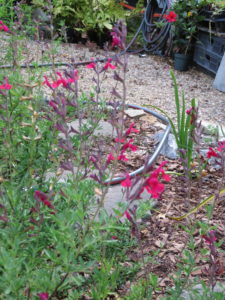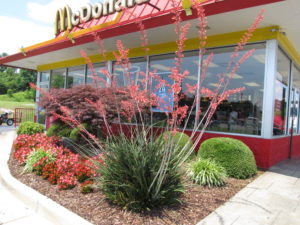If you’re search for top performing plants, especially very drought tolerant, take a look at the picks from Plant Select®. This is a nonprofit collaboration of Colorado State University, Denver Botanic Gardens and professional horticulturists. Their mission is to seek out and distribute the very best plants for landscapes and gardens from the intermountain region to the high plains and beyond. Plants chosen for program exhibit these eight attributes:
- Flourish with less water
- Thrive in a broad range of conditions
- Habitat-friendly
- Tough and resilient in challenging climates
- One of a kind/unique
- Resist disease & insects
- Long-lasting beauty
- Non-invasive
Here are four Plant Select® picks that prosper across most areas of Tennessee:
‘Furman’s Red’ Salvia (Salvia greggii ‘Furman’s Red’)
This hardy selection of a southwestern ever-blooming sage grows 18-24 inches high and wide (USDA hardiness zones 5b-10). Crimson to scarlet flowers form in repeated flushes from late spring, summer and autumn. It is deer resistant and drought tolerant; provide good soil drainage and does poorly in soggy winter soils. Wait to cut old plant back in spring.
Red Rocks® Penstemon (Penstemon x mexicali Red Rocks®)
This hybrid penstemon forms a bushy clump, 14-18 inches high and 12-14 inches wide of narrow green leaves (zones 4b-8). Short spikes of bright rose-pink trumpet flowers bloom, on and off, through most of the summer and attract butterflies and hummingbirds. Narrow, dark green leaves form an attractive mound. It sports a constant succession of bright rose flowers all summer. Red Rocks thrives in a wide range of sites and soils.
‘Standing Ovation’ Little Bluestem (Schizachyrium scoparium ‘Standing Ovation’)
This warm season ornamental grass grows 24-36 inches high and 15-18 inches wide (zones 3-8). It performs well in poor, dry soils. It holds its tight upright growing habit all 4-seasons. Spikey bluish-green leaves transition to a brilliant display of red shades, changing to deep purple from August into October. Seed heads stand upright through winter and provide winter interest and food for birds. It can be utilized in mass plantings or meadow designs.
Red yucca (Hesperaloe parviflora)
This shrub native to Mexico and Texas grows 3-4 feet tall and 1.5 to 2 feet wide (zones 5-10). Tall spikes of brilliant coral-pink, yellow-throated tubular blossoms curve skyward and attract hummingbirds from early summer to autumn. It prefers a porous loam soil and avoid frequent irrigation. Tidy up plant by pruning off brown foliage and seedheads in late winter. Deer resistant.



 Posted in
Posted in 
